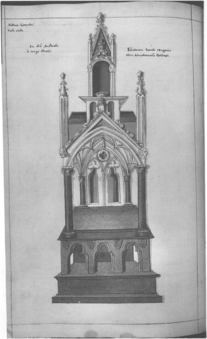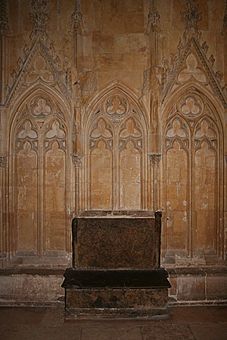Little Saint Hugh of Lincoln facts for kids
Quick facts for kids Little SaintHugh of Lincoln |
|
|---|---|
| Little Sir Hugh | |
| Born | 1246 |
| Died | Before 27 August 1255 (aged 8–9) |
| Venerated in | Folk Catholicism |
| Major shrine | Lincoln Cathedral |
| Feast | 27 July |
Hugh of Lincoln (born 1246 – died 27 August 1255) was a young English boy. His death in Lincoln was wrongly blamed on Jewish people. He is sometimes called Little Saint Hugh or Little Sir Hugh. This helps tell him apart from another saint named Hugh of Lincoln (who died in 1200). The young Hugh was never officially made a saint. So, calling him "Little Saint Hugh" is not quite right.
Hugh became famous because of a false accusation called a "blood libel". This was a harmful lie that claimed Jewish people killed Christian children for religious reasons. Some historians believe that church leaders in Lincoln encouraged this story. They hoped it would bring many visitors and money to a new holy site. Hugh's death is important because it was the first time the King believed such a false story. King Henry III himself got involved. Because of this, the story became part of history books, old stories, and songs. These songs were sung for hundreds of years.
Contents
The Story Behind the Accusation
False stories of children being killed for rituals became more common. This happened after a book about William of Norwich was shared. William was a child who supposedly died in 1144. Other similar accusations followed, like those about Harold of Gloucester (1168) and Robert of Bury (1181). The story of William and similar rumors influenced the myth about Hugh. Church officials might have spread these accusations. They hoped to create local holy sites to attract visitors and donations.
Around the time of this event, King Henry III was collecting a lot of money from Jewish people through taxes. This made it hard for Jewish moneylenders. They had to make sure their loans were paid back. If not, they might sell the debts to Christians. The King's family and friends often bought these debts. They wanted to take people's property if the debts were not paid. These actions by King Henry later led to a big conflict called the Second Barons' War.
The Church also made many rules against Jewish people. The Vatican said that Jewish people should live separately from Christians. Christians were not allowed to work for Jewish people, especially in their homes. Jewish people also had to wear special yellow badges to identify themselves. These Church rules led to many English towns forcing Jewish communities to leave. King Henry III made most of these Church rules into laws in 1253. This was called the Statute of Jewry.
When Hugh of Lincoln was falsely accused, King Henry III had sold his right to tax Jewish people to his brother, Richard, Earl of Cornwall. However, the King made a rule. If any Jewish person was found guilty of a crime, their money and property would go to the King.
At the time of Hugh's death, many Jewish people from all over England were in Lincoln. They were there to attend a wedding.
The False Accusation and Myth
Nine-year-old Hugh disappeared on July 31. His body was found in a well on August 29. People claimed that Jewish people had captured Hugh. They said he was tortured and then killed by crucifixion. It was also claimed that his body was thrown into the well. This was supposedly after attempts to bury it failed, as the earth "expelled" it.
The story told in Paris was the most famous. It was spread by a popular storyteller. However, it is thought to be the least accurate of the stories from that time. Other accounts came from places like the Annals of Waverley and Burton Abbey.
The Bishop's Involvement
A Jewish man named Copin reportedly confessed to the murder. He was supposedly offered freedom if he confessed. Copin was likely questioned under torture by John of Lexington. John was the brother of Henry of Lexington, the new Bishop of Lincoln. John also worked for the King. Modern historians believe that church leaders likely worked together to make the accusation seem true. They wanted to gain money from visitors to a new holy site.
The King's Actions
Several things made this event even more impactful. King Henry III arrived in Lincoln about a month after the first arrest and confession. He ordered Copin to be executed. The King also ordered the arrest of ninety Jewish people at random. They were connected to Hugh's disappearance and death. They were held in the Tower of London. They were accused of ritual murder. Eighteen of these Jewish people were hanged. They refused to take part in the court process. They said it was a fake trial and would not ask a Christian jury for mercy.
A knight from Toledo, Garcias Martini, helped get Benedict, son of Moses of London, released. Benedict was likely the father of Belaset, whose wedding was taking place. In January, another Jewish person, John, was pardoned. This happened after a Dominican friar helped him. A trial for the remaining 71 prisoners took place on February 3. A jury of 48 people found them guilty. They were sentenced to death. After this, the Dominicans or Franciscans, along with Richard of Cornwall, stepped in. By May, the prisoners were released. It is possible that doubts about their guilt had grown. It is unlikely the monks or Richard would have helped if they believed the serious charge was true.
It is still unclear why King Henry and his servant John of Lexington believed the accusations. John of Lexington might have believed them because of his connections to the church leaders in Lincoln. This included his brother, the Bishop. They would benefit from people honoring 'martyr' Hugh. John might have truly believed what he heard. While the King made the final decision, some historians think he was weak. They believe John of Lexington could easily influence him. One historian describes Henry III as "a suspicious person who flung charges of treason recklessly, [who] was credulous and poor in judgment, and often appeared like a petulant child." This helps explain why he acted as he did. Another historian believes the money King Henry received was a big reason for his actions. He had given his right to tax Jewish people to Richard of Cornwall. But he still got the property of any Jewish person who was executed.
Honoring Hugh
After news of Hugh's death spread, people said miracles happened because of him. He became one of the youngest people considered for sainthood. July 27 was unofficially made his special day. Many local 'saints' from the Middle Ages were not officially made saints. Instead, local people called them saints and honored them. 'Little Saint Hugh' was honored by local people for a while. But he was never officially recognized as a saint. Over time, questions were raised about how quickly he was called a saint. Hugh was never officially made a saint. He was never part of the official Catholic list of saints. The Vatican never included the child Hugh in its list of martyrs. His traditional English feast day is not celebrated.
Lincoln Cathedral gained from this event. Hugh was seen as a Christian martyr. Places linked to his life became important for religious journeys.
The shrine was built soon after Jewish people were forced to leave. It included decorations honoring Edward I's wife, Eleanor of Castile. She was not well-liked because she bought and sold many Jewish debts. Her goal was to take the land and property of those who owed money. The honoring of Hugh was popular until the 1360s. But it seemed to decline in the next 50 years. By 1420–21, it was bringing in very little money. The shrine was mostly destroyed after the English Reformation. During the Cathedral's repair in 1790, a stone coffin was found. It was about 3 feet 3 inches (1 meter) long. It held the skeleton of a boy. Samuel Hieronymus Grimm drew a picture of it.
What Hugh's Story Means Today
The false story of ritual child murder was a harmful idea. It continued to be a theme in antisemitism and English culture for a long time. The Hugh story is mentioned in Geoffrey Chaucer's Canterbury Tales, in a part called The Prioress's Tale. Christopher Marlowe also seems to refer to the story in his play The Jew of Malta. In the play, a friar asks about a Jewish person, "What, has he crucified a child?" Marlowe might have known the story from the Paris account. The story was even retold as a fact in Thomas Fuller's 1662 book Worthies of England.
Songs about the event were sung in England, Scotland, and France. The earliest English and French versions seem to have been made around the time of the event. The "Sir Hugh" song had many different versions. It was still well-known in the 1800s and 1900s. Versions could even be found in the United States.
One historian says that the false story created by John of Lexington contributed to some of the darkest parts of anti-Jewish prejudice.
The Hugh myth continued to be important into the 1800s. At that time, people who were against Jewish people tried to "prove" the story was true. In the 1900s, a well in the old Jewish neighborhood of Jews' Court, Lincoln was advertised. It was called "the well in which Hugh's body was found." However, this well was built sometime before 1928. It was made to attract more tourists to the property. A school in Lincolnshire, St Hugh's School, Woodhall Spa, was named after Little St Hugh in 1925. Its school badge showed a ball going over a wall.
In 1955, the Church of England placed a plaque at the site of Little Hugh's former shrine in Lincoln Cathedral. It has these words:
Here lies Little St Hugh
Murdered by Jews On 27 July 1255
See also
- Antisemitism in the United Kingdom
- Berechiah de Nicole
- Sir Hugh
- St Hugh's School, Woodhall Spa
- Andreas Oxner
- Robert of Bury
- Simon of Trent
- Werner of Oberwesel
|



